|
FAQs about Yellow Tang Disease/Health
10
FAQs on Yellow Tang Disease: Disease 1, Disease 2, Disease 3, Disease 4, Disease 5, Disease 6, Disease
7, Disease 8, Yellow Tang Disease 9,
Yellow Tang Disease 11,
Yellow Tang
Disease 12, Yellow Tang
Disease 13, Yellow Tang
Disease 14, Yellow Tang
Disease , & Paravortex/Black Spot
Disease,
FAQs on Yellow Tang Disease by Category:
Diagnosis,
Environmental, Nutritional,
Trauma,
Pathogenic (infectious, parasitic),
Social, Genetic,
Treatments
Related Articles: Yellow
Tangs,
Related FAQs: Best Yellow Tang
FAQs, Yellow Tangs 1, Yellow Tangs 2, Yellow Tangs 3, Yellow Tangs 4, & Yellow Tang FAQs:
Identification, Behavior, Tang
Behavior, Compatibility,
Selection, Systems, Feeding, Reproduction, & Purple Tangs, Striped Sailfin Tangs, Zebrasoma Tangs, Zebrasoma Identification, Zebrasoma Behavior, Zebrasoma Compatibility, Zebrasoma Selection, Zebrasoma Systems, Zebrasoma Feeding, Zebrasoma Disease, Zebrasoma Reproduction, Surgeons In General, Tang
ID, Selection,
Compatibility,
Systems, Feeding, Disease, Fish Worms Diseases,
|
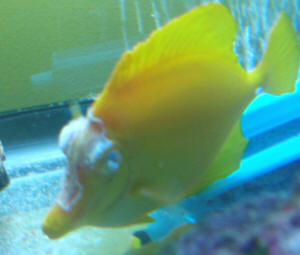
|
Surgeonfishes: Tangs for Marine Aquariums
Diversity, Selection & Care
New eBook on Amazon: Available here
New Print Book on Create Space: Available
here
by Robert (Bob) Fenner |
 |
|
Yellow Tang Sick 8/30/10
Hello and thank you for taking my question.
<Howsit?>
I have a Yellow Tang that has been with me for close to 7 years.
I transferred him from my old 40g tank to the new in-wall 180g
(220 total system volume) a few months ago. He was doing great
until a couple weeks ago when his interest in his normal daily
Nori waned. He's never taken to foods floating in the water
column such as Mysis, Rod's Food,
etc... He only really cares for Nori.
<Mmm, needs more nutritionally>
Along with his lack of appetite, I noticed his gills were
irritated and he is breathing fast, which is my main concern. He
is still somewhat fat but I can tell he's losing weight from
not eating. Fellow tank mates include a male Lyretail Anthias,
Cleaner Wrasse, Cleaner Shrimp, and some snails. I've
attached some pictures for reference.
<No images attached... Oh, I see below>
Thank you for any help you can provide and water parameters are
below as well.
Salinity 1.025
Temp 80F
Alk 9.0
Ammonia 0 ppm
Nitrate 1 ppm
Phosphate - undetectable (going through a brown hair algae cycle
at the moment)
<I see this... and it concerns me>
Tang 1
[IMG]http://i202.photobucket.com/albums/aa113/drummereef/180g%20Reef%20Tank/IMG_1227.jpg[/IMG]
Tang 2
[IMG]http://i202.photobucket.com/albums/aa113/drummereef/180g%20Reef%20Tank/IMG_1230.jpg[/IMG]
FTS
[IMG]http://i202.photobucket.com/albums/aa113/drummereef/180g%20Reef%20Tank/IMG_1289.jpg[/IMG]
Sump Room Equipment
[IMG]http://i202.photobucket.com/albums/aa113/drummereef/180g%20Reef%20Tank/IMG_1268.jpg[/IMG]
Thank you!
-Brett
<Well the dorsal fin seems mis-shapen/foreshortened and there
is some lack of coloration in the pectorals and elsewhere... this
could be due to being confined to the forty for so long... The
algae in the new system is my main guess... I think this fish is
being poisoned by it. I would be either moving this fish
elsewhere or dealing with this algae post haste. Read here:
http://wetwebmedia.com/marine/maintenance/maintindex.htm
scroll down to Algae, Control...
Bob Fenner>
|
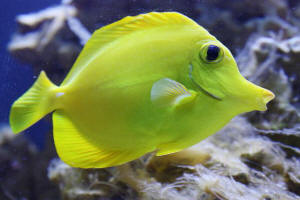 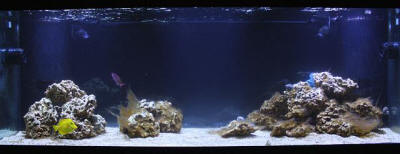
|
Re: Yellow Tang Sick, Poss. BGA
involvement 8/30/10
Thanks for the reply Bob. The 180g was recently set up and
cycled but is/has been going through it's first major
hair algae cycle. Algae poisoning, I've never heard of
this?
<Actually, quite common>
I agree the tang was kept in the 40g far too long, bad
decision on my part I know but was fat and acting fine even
after adding him to the 180g. I have implemented some
Mexican Turbo snails that are eating the algae quite well -
but at a snails pace.
<Seems reasonable...>
Along with that I run Rox 0.8 Carbon and granular GFO. What
could possibly be in the algae that would poison the
fish?
<The list of chemicals is indeed long. Better for you to
search the Net re>
Is it that he is consuming the algae that is making him
sick?
<Not necessarily. Can/could be toxins released in the
water>
Like I said, I've tried Nori, Red Algae, Rod's
Food, Mysis... but his favorite was always the Nori. Never
took to anything else. Also tried garlic enhancement to no
avail. Puzzled....
Thanks again for the quick reply,
-Brett
<Certainly welcome Brett. BobF>
Re: Yellow Tang Sick
It's time to change it anyhow so you think it would be
wise to discontinue the GFO?
<Removing soluble phosphate thus is fine as a nutrient
control approach in a setting such as yours (sans
macro-livestock that is chemoautotrophic)>
I can't see how the Carbon wouldn't help the
situation if the algae is releasing toxins into the water
column at this
point. Thoughts?
<Good grade carbon can/will help as well. B>
Thank you again,
Brett
Re: Yellow Tang Sick 8/30/10
Thank you Bob. One last picture for you. This is taken with
the tank lights off but with the camera flash on - sprr. I
thought it looked like brown hair algae but what do you
think? Link below....
Thanks,
Brett
http://i202.photobucket.com/albums/aa113/drummereef/Miscellaneous/IMG_1342.jpg
<Quite possibly a Cyanophyte... need to see through a
'scope to tell for
sure... Read where you were referred initially. B>
Re: Yellow Tang Sick
Will do, thanks so much Bob. Much appreciated.
-Brett
|
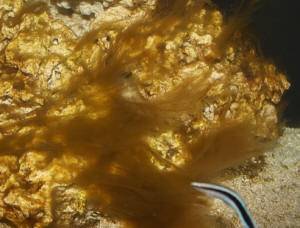 |
|
Yellow Tang... beh. 8/2/10
Hi! I've only had my yellow tang a couple of months. Yesterday, I
noticed above one of his eyes a dark spot. He was still very energetic
and eating. This morning, he is hiding and not eating. Also, he is
black above both of his eyes...just a small dark circle above each eye.
There is no pitting or streaks or anything else. What can I do for
him?
Thanks,
Bev
<Likely these marks are either "natural" or resultant from
capture, poor decompression process... in either case there is naught
to do but provide good care. Bob Fenner>
Yellow Tang Problems
One other thing...the discoloration looks like it's underneath the
skin.
Like it's in his head, on the top, between his eyes.
<Is indeed. B>
|
I think my Yellow Tang is dying! 6/3/10
Dear Wet Web Media,
<Gabe>
I've enjoyed your website since I inherited a salt water tank
5 years ago and also a proud owner of Bob Fenner's
Conscientious Marine Aquarist. I have a 200 gallon tank, fish
only, live rock with protein skimmer. The tank has only 8
inhabitants (yellow tang, dwarf flame angel, threadfin butterfly,
tomato clownfish, Firefish, Hawkfish, a damsel, and one fire
shrimp) The water parameters are nitrate: 20, nitrite 0, ammonia
0, ph 8.4, alkalinity 300, temp 82, sp gravity 1.024. I've
had this yellow tang for 2 years. The newest fish has been in the
tank for one year. It used
to eat everything (seaweed, flake, brine shrimp, frozen marine
mixes, pellet food) but for the last two days it has been looking
whiter, the dorsal fins are spiked up, he might be breathing fast
but I don't really can't tell, and he won't eat
anything.
<This fish IS beat>
The other fishes look fine, and he's the largest in the tank
measuring 3 inches and has never been bullied. There hasn't
been any new tank issues or changes. I've included a picture.
Please help! I'm scared he's dying.
-Sincerely, Gabriel
<Either summat is seriously missing nutrient-wise, and/or
water quality has some very bad issue. Please peruse these
files:
http://wetwebmedia.com/ytangdisfaqs.htm
and the linked files in the series above. Bob Fenner>
|
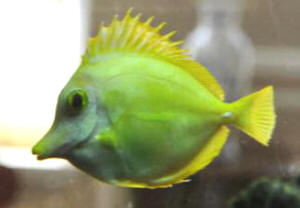 "Crew cut" Tang... "Crew cut" Tang... |
Fish aggression in quarantine, Yellow Tangs
5/27/10
Dear Crew,
<Hiya - Darrel here>
I'd read that adding a group of yellow tangs was possible, but for
best likelihood of success they should be placed at the same time.
<Yes. Keep in mind that, just as water seeks it's own level -
fish find their own place in the hierarchy. In NATURE '¦ the
weakest is almost always lost. What we're trying to do is minimize
that.>
I got 3 small ones (approx. 2") and put them in a 10g quarantine
tank.
<10g is a tad small for 3 tangs of ANY size>
One fish is bullying/displaying the typical signs of tang aggression.
The 'victim' just stays in one corner all the time.
<Not unexpected>
I was planning to keep them in QT for 2 weeks, then a 5 minute
freshwater dip, then directly into the main 125g system.
<We all have our own experiences, Chris. Mark Twain once wrote
"the problem is not that we don't learn from our experience,
it's that we learn TOO MUCH. Consider the cat that jumps on a hot
stove. The cat, having sat upon a hot stove lid, will not sit upon a
hot stove lid again. But he won't sit upon a cold stove lid,
either.>
<For me, what that means is '¦ SIX weeks, not two. No
shortcuts, no excuses '¦ as Earl Schieb used to say
"No, ups, No extras!" SIX weeks. Too many times I've had
fish in quarantine until I thought "If he was going to have a
disease, he'd have had it by now" only to find that at 5
weeks, 6 days and 3 hours .. I was wrong.>
<<I can see his persona-Ruh self resurrected in some distant
future... "I'll paint any spaceship for
9,999,999...">>
Does the stress from bullying justify placement of any of them into the
main tank earlier than planned?
<In a word '¦ NO!>
<in two words '¦ NO WAY!>
<in three words .. Not A Chance!>
<in four words '¦ Not On Your Life!>
<.>
<I can keep this up all night '¦ but I hope you get the
point. NO amount of ANYTHING gives us the right to risk the lives of
the inhabitants of our main tank. EVER!>
<!!>
<If you only have one quarantine tank '¦ then you're
that guy. The mythical guy that only has one extra tank. Most of us
have more gallons of extra tanks than we have display tanks -- and this
is the reason.>
If not, what else would you recommend?
<Two choices. Move the little guy to his own QT tank (and start his
QT clock back at zero again!!!) -- or move ALL of them to a larger
(30g) tank that has several pieces of PVC pipe and maybe even several
pieces of dead rock -- where you can create what is called "visual
privacy" for the two combatants: places where they can both exist
without having to see the other>
In anticipation of a suggestion to get a bigger sized QT, I'll
start looking around for a larger used tank, but is there another
solution using my existing setup, such as simply using a tank divider,
or would this be too confining?
<No tank divider in a 10g .. but for your 30, 40 or 50g QT tanks
{plural} (welcome to the Brotherhood!!!) then perhaps yes>
Chris
<That's my 2 cents ... but I'm going to ask the boss if I
missed anything. RMF??>
<<Well, I think you've summed up your stance, in, umm, your
own usual, umm particular... idiom. BobF>>
Re: fish aggression in quarantine
5/28/2010
Darrel:
<Chris>
I appreciate the promptness of your response. At the same time, I must
reply to your comments, which at first read seemed at times somewhat
condescending and smug. After noticing Mr. Fenner's postscript,
however, it's possible that may have not been your intent, but
rather, your communicating style just leans towards hyperbole.
<<Heeeee! I'll say! RMF>>
<Sorry that you didn't 'get' my sense of humor, Chris.
It takes a certain dementia to do this job and mine runs toward weird
humor. Mostly I get positive feedback, but Neale Monks does point out
from time to time that my writing style doesn't always move to
other English-speaking countries and must be downright hideous when
literally translated into other languages. Yours is a letter that
would seem to support his position.>
While I don't contest that a larger quarantine system and/or
multiple tanks would be better, I do take issue with your statement
that I am the 'mythical guy that has only one other tank' and
that 'most of us have more gallons of extra tanks.' Based on
the 13 pages worth of 'Quarantine-related' questions within the
WetWebMedia website, it's clear that a great many of the posters
have historically used NO quarantine methods whatsoever, much less use
multiple tanks. I am sure that you (meaning all WetWebMedia
consultants) realize that the people who write to you are, for the most
part, not experienced aquarists like yourself, but novices.
<Chris, probably every last one of us has used the "no
quarantine" method when we started out. We live and learn. The
problem is that Marine Aquaria is both art and science and while we all
agree on the science, the art is different between us all. So we get a
QT tank and then have an "oops" just like you did and we
acquire a second. Then, in the process of something else we see that we
should have done "thus & so" and suddenly we have a
third. That 'mythical guy' I was joking about was an effort to
make you feel that you hadn't done anything wrong -- that we have
all followed this same path. Again, sorry it didn't come
across>
I agree with you that we in the hobby are custodians of often fragile
life forms, and this demands a certain level of responsibility.
However, we also balance that responsibility with our own respective
individual constraints, whether they be financial, space related, time
related or otherwise. The ability to maintain multiple 'spare'
tanks is not as simple as you proclaim it to be. Now you may say,
'if you aren't able to provide the extra space/tanks, you
shouldn't have bought the fishes.' That I chose to quarantine
three small yellow tangs in a 10g tank may not be ideal or proper, but
neither was it borne out of complete arrogance/ignorance.
<au contraire. I assumed you made that choice based on the best
information available to you at the time combined with the limitations
of space and money. Just like all of us>
I opted to do so after reading from Mr. Fenner's The Conscientious
Marine Aquarist, page 325: 'Yellow and Hippo (Yellow-tail Blue)
Tangs can easily get along on a 10- or 15-gallon allocation when they
are very small; the larger species double that capacity." Knowing
that this confinement was only for a limited period of time and after
reading that excerpt, I felt this size quarantine tank could suffice.
If I was mistaken in my interpretation of that passage (i.e. 10 gallons
= 1 tang), then it is now duly noted.
<Nope - you probably interpreted it just fine. But see, this is
exactly my point about the science and the art of it: Bob Fenner has
VASTLY more experience than I do in all areas of Marine Aquaria. Vastly
more. His science in unimpeachable but in this particular case, your
three tangs stand as living proof, I was right. BUT YET that
doesn't mean Bob is wrong. The problem with our art is that MOST
small tangs get along '¦ USUALLY in these cases, etc. Tangs
act differently as pairs than triads than schools, too.>
<which brings us to the discussion of quarantine>
Secondly, you were quite emphatic ('!') in your insistence on a
6-week quarantine, with no exceptions whatsoever. Please explain how
you reconcile that position with page 170 of Mr. Fenner's The
Conscientious Marine Aquarist ('A proper interval (generally a
minimum of two weeks) must go by in which the specimen in the
quarantine tank shows no ill effects of transport or disease. Some
public aquariums, with small fortunes tied up in their exhibits, wait
four weeks for additional security'); Page 13 of John Tullock's
Saltwater Aquarium Models ('I suggest a minimum quarantine of two
weeks'); or Page 114 of Michael S. Paletta's The New Marine
Aquarium ('Every new fish, whether given a dip treatment or not,
should be placed in the quarantine tank for 3 to 4 weeks').
<Here's how I explain it: I've lost fish 5 weeks into
quarantine. I tried NO QUARANTINE and I tried TWO WEEKS and I tried
FOUR WEEKS and like almost all of us, I've tried "If he was
sick he'd have shown it by now" and all of them failed. So I
learned from MY experience to use the largest possible tank (lowest
possible bio-load produces the least chance for diseases and parasites
to reach the other fish) and wait SIX weeks. I then took great pains to
quote Twain as a way of admitting that I may have over-learned from my
experiences. BUT with that said, I haven't acquired a communicable
disease or parasite in my display tank since I started holding to 6
weeks.>
<No matter how you do this, YOUR experiences will vary -- and
they'll vary from the documentation and advice you get from all
sectors. The science of this is well documented but keeping the fish
alive and healthy is also an art and the methods employed are very much
in the eye & hand of the artist.>
<In fact .. to go off on a tangent '¦ do you remember the
Wizard of OZ? The scene where Dorothy meets the Scarecrow at the
crossroads and asks how to get the Emerald City? The Scarecrow says
"some people go that way and others go the other way
'¦" and gives her every possible answer, which also
means, in effect NO answer. The same holds true for this hobby and as
newbie, it frustrated the bejeesus out of me when I wrote in with a
sick Blue Tang (Ick) and I wanted an expert to tell me what to do.
Instead what I got was an expert telling me a bunch of different things
I COULD do and what OTHER people do. At the end of three sets of
emails, I was exactly like a College Graduate: my head was swimming
with knowledge and yet I didn't have the first CLUE what to do or
how to use that knowledge.>
<So when someone writes in about QT - I say "6
weeks">
<When they write in about introducing an unquarantined fish - I say
NO!!>
<Then - if I think I went too far or over my head, I refer my answer
upstairs, just to be sure.>
If this rebuttal comes across as strong, it's only because I want
to emphasize that chiding those seeking your help and expertise is
counterproductive. I know that most of you are unpaid volunteers and
your time is valued. However, a youngster new in the hobby receiving
that type of response might easily become disenchanted.
<You could be right. My experience, however has been the opposite -
that most people seem to be pleasantly surprised that someone took the
time to be funny and personal in the response. A HUGE unknown is also
the state of mind of the reader.>
And ultimately, the more of us that experience the joy of responsibly
keeping live aquaria and learn to appreciate nature in its different
forms, the better. I have great respect for Mr. Fenner because, even
with his vast knowledge, he offers straightforward advice with patience
and respect
<Yes, he does>
(I personally have had the privilege of his response to some of my past
questions), regardless of the questioner's experience or
expertise.
<So have I. In fact, it was in such a series of email exchanges that
he tricked me into becoming a member of the team (there was supposed to
be free food!!!!!)>
Chris S.
<Again Chris, I apologize for my sense of humor. It's one of a
great number and depth of character flaws I possess (as my ex-wife
could spent days reminding me) but the intent was to answer your
question and amuse the reader as the same time. It seems in this case
that I did neither very well>
<You'll notice that you're not alone: at the end of my
response, EVEN BOB called me an Idiom>
Yellow Tang Trouble -- 05/21/10
Hello all. I have been reading your site quite a bit and getting great
information. Excellent site. My Yellow Tang is in trouble. I was
treating him for lateral line with Fish Zole,
<Metronidazole... Flagyl generically>
recommended by LFS.
<Mmm... only if the root cause of this erosive condition is
Parasitic... rare... will such a treatment avail... OTOH, this compound
is very toxic... one dose is all fishes should ever be exposed to...
Damages nephric/kidney
components... mortuus est. Instead, water quality, nutritional aspects
are almost always the basal cause of HLLE... Read here:
http://wetwebmedia.com/HLLESWCauseF.htm
and the linked files above...
and here: http://wetwebmedia.com/metranidazole.htm
and the linked...>
After day 5 he started to turn red so I stopped. No one seemed to know
what it was
<What? Nonsense!>
and said it was most likely from treatment.
<Oh, yes... tis so>
So I find a picture similar on your site. Should have come here
first.
The Tang is in a QT tank right now.
<Won't be fixed here>
I have been using vitamins in his water/food.
<Good... return this fish to the main system>
Water tests are 0. PH is 8.2 and doing water change daily. Yesterday he
did not eat his Nori soaked in vitamins nor the frozen herbivore food
and the same for this morning. Not a good sign I'm sure. Is there
anything else I can do? Should I start antibiotics again?
<No>
Would putting him back in the main tank be a bad idea?
<No; a good one>
He's been in the 10 gallon QT for 3 weeks which may be too small
for a long period. Also It seems there is no set answer on how this
happens.
<Double nonsense... the etiology of this condition, and its arrest,
reversal is well-worked out...>
Water quality, which seems to be great and no problems with hippo tang
or bicolor angel. Stress...he was boss of the tank....although I never
seen much picking. Voltage....I have heard this one is a myth. Any
ideas here?
<... see WWM re>
Thanks for any ideas and have a great weekend.
Sarah
<Read where you've been referred and write back if you still
have questions, concerns. Bob Fenner>
Re: Yellow Tang Trouble - 5/23/10
Bob-
Thank You for all your help. The tang is looking better since I put him
back in the main tank. Less red, eating, and active. I believe this can
be reversed with time.
<I do agree>
On another note...I have noticed a new round hole in my live rock that
seems to be changing a little each day. Looking around and wondering
what would create this hole.
<Mmm, could be a large number of biological predators, or even
abiological factors at play here>
Mantis Shrimp has come to mind. Can they really crack glass?
<Reportedly, yes>
Does pulling the rock and putting fresh water in the hole really flush
them out?
<I have seen/done this... better with Seltzer... and more
fun>
Always a new challenge in this hobby but well worth it. I have asked
for your book for my birthday. Looking forward to a good read.
Thanks again.
Sarah
<Welcome Ms. S., BobF>
I'm not 100% sure this is black Ich.... SW parasite
diag. 4/21/10
Hi crew....
<Gretchen>
I've scoured and gathered as much info as I could about black Ich
around the web and especially your site. For starters, about my tank:
125g w/ 60g sump, skimmer, live rock, live sand, above the tank
refugium, plus in sump refugium, 2 Koralia 4's, and mag18 return
pump. Tank is Fowlr -- but has a rock w/ mushrooms that hitchhiked,
very few inverts (5 or 6 hermits, 5 or 6 assorted snails). Tank has
been established for 4 months, livestock were moved from a smaller
tank. Inhabitants are 1 ocellaris, 1 Banggai Cardinal, 1 Firefish, 3
blue/green Chromis, 1 diamond watchman goby (added him a month ago),
and 1 small pistol shrimp -- and our latest addition, a yellow tang, is
the reason for this email.
First off, I did not QT (yes, I know, this is the risk I take,
especially with tangs). I got him 4 days ago from my LFS. Drip and temp
acclimated for 2 hours, and he's been eating clipped algae sheets,
Mysis, Spirulina, anything I put in there. He's a small one.
Today, I noticed black splinter looking things...
<... splinter?>
this is why I'm emailing. I cannot get a picture -- he's camera
shy.
<You need to practice>
It was suggested in a forum that it could be black Ich. There are only
2 or 3 pictures I've seen (one is that yellow tang image in your
site and one is black Ich on a hippo tang),...the problem is, the ones
on my tang don't look like spots...they literally look like tiny
splinters of wood. Could that be the start of black Ich?
<Mmm, no... perhaps these are monogenetic Trematodes, maybe
parasitic copepods...>
I also noticed a very light gash along his side. I'm thinking it
could have happened while trying to scratch himself on the rocks to get
rid of the parasites?
<Could be>
The little "splinters" look like the gash, except they're
poking out a bit....ironically, as I write this, I'm wondering now
if this could be the start of WHITE Ich...hrm..so if it is white Ich,
would the scratching start before the white spots show up?
<Yes, could>
Ok, so if this is black Ich, how long before it turns into the spots
that I see on the fish? Like, what comes first -- the itching or the
spots?
<... read here: http://wetwebmedia.com/blkichsympf.htm
and the linked files above>
Some observations about his behavior:
- I see him brushing the sand and sometimes the rock with his pelvic
fins, like he's just brushing the areas. But I could interpret them
as rubbing because of the parasites.
- When I first got him, he paced up and down the tank, pressing himself
against the glass..but I attributed it to just adjustment time.
Upon some research on products, I settled on getting Seachem Paraguard.
I even spoke to a representative. It's not copper or formalin
based.
<It's Glutaraldehyde>
It's invert safe, but with caution -- she suggested a partial dose
at first to get them used to it. Since I'm Fowlr, I will just take
out the shrimp, cuc, and the rock w/ the mushrooms and put them in a qt
tank. I will treat the main tank.
<I would not do this>
I'm assuming the eggs have been dropped and in the substrate at
this point, so I want to kill them there, too. The rep and my lfs did
warn that with any meds, it will cause stress, so I'm aware that I
might have some casualties, but I'm hoping it turns out well. Any
opinions you might have with this product are welcome (so far, majority
of the reviews raved about this product).
<People have got to learn... as in understand, that anyone writing
anything on the Net doesn't make it so...>
As always, thanks for your time, crew! You guys are awesome!
<Is there a chance you have access to a low power microscope? Please
search WWM re such use. Bob Fenner>
|
Yellow Tang Septicemia? Zebrasoma Disease\treatment
4/18/2010
Crew!
<Hi Ross.>
Thought I would shoot you a quick question.
<Fire away.>
Background: I have been treating my fish for Cryptocaryon
irritans in a hospital tank for the last 29 days. Fish include 4
Chromis, 2 ocellaris clowns, a Cardinalfish, and a 6-line wrasse
(all quite small - probably 11 "inches" of fish total).
Have not seen any sign of the parasite for quite a while now and
am just waiting for the display tank to clear out of tomonts.
<OK>
Just in the last two days the yellow tang has lost interest in
Spirulina flakes (normally eats these with great enthusiasm),
although it is still eating frozen Mysis. All of the other fish
are fine. I also noticed redness in some of the tang's fins
and along the lateral line.
<Not a good sign.>
Past lurking on WWM leads me to believe this may be septicemia,
but this is my first experience with it.
,Looking at the picture, I would agree.>
I looked for some Seachem Kanaplex, but was only able to come up
with some API Triple Sulfa. The box indicates usefulness in
treating septicemia, but I have grown VERY skeptical of marketing
information and the extraordinary claims on product
packaging.
<It can help, but isn't the drug of choice.>
So, here I am to sit at the feet of the gurus. Do you think the
diagnosis is remotely accurate (picture of tang attached)?
<Yes.>
Also, do you like Triple Sulfa for treating said condition?
<Not the best choice, but certainly better than nothing. Start
treating ASAP. Doxycycline is a better choice, but it is only
available through a vet or online through http://www.nationalfishpharm.com
>
<Follow all instructions closely and keep an eye on water
quality.>
Thank you for your help, and thanks for all of the good work you
are doing at WWM. What an excellent resource - if only I could
search my copy of CMA with the ease of searching WWM...
<<Perhaps someday soon. RMF>>
<Thank you for the kind words.>
Ross
<MikeV>
|
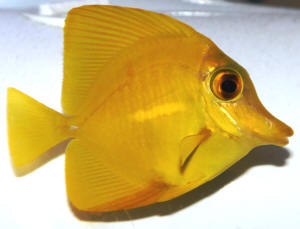 |
|
Yellow Tang, dis., env. and more 4/5/10
Hi, I am writing regarding my Yellow Tang that has red/pink
crater like sores on her face and body (I have included
pics).
<I see these>
I have a 36 gallon tank
<... too small>
and purchased the Yellow Tang about three months ago (I was told
our tank size was adequate for this type of fish by the LFS which
I know now is not the case) the water was cycled for 2 years and
has about 10 lbs of live rock, 2 ocellaris clown, 2 cleaner
shrimp and 1 green Chromis (2 died).
The water parameters today are PH 8.2, salinity 1.24,
<1.024>
nitrates trace amount, ammonia 0 and nitrites 0. About two weeks
ago I purchased a coral life T5 light with dual 31-watt 10k
actinic bulb and at that time she started racing back and forth
in the tank. She has since calmed down but shortly after we
noticed the craters ( she did have some flesh colored craters
since purchase but they were not very noticeable and only in a
few spots) spreading and becoming pink/red in color. A few other
problems were discovered with the water parameters in the last
few days due to using a versa top
<Really? Due to the aquarium light housing fixture?>
that has been removed. The salinity raised to 1.29 and the temp
of the tank raised to 85 degrees (the thermometer was not working
properly and was registering 80 degrees).
<85 F. is too hot. See here: http://wetwebmedia.com/temp_faqs.htm
and the linked files above>
After contacting the LFS I was told that these craters were
probably due to stress
<Mmm, to a degree likely so... but also water quality,
nutrition in the main>
so the salinity has since been corrected and we are slowly trying
to drop the temperature. I have been feeding her pigmy angel
formula, ocean nutrition formula two flakes, seaweed and frozen
seafood mixture soaked in garlic. I also use Kent marine
essential elements.
<I would not use, introduce anything... chemicals you
don't, won't test for. In other words, I'd stop using
this product>
My question is what is she suffering from and is there anything
else I can be doing to fight this? Thanks so much, Anthony.
<Please read here: http://wetwebmedia.com/ytangdisfaqs5.htm
and the linked files above, till you understand... and here:
http://wetwebmedia.com/HLLESWCauseF.htm
and the linked "Cures" FAQs files above.
Bob Fenner>
|
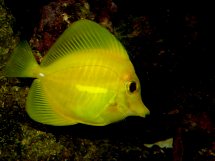 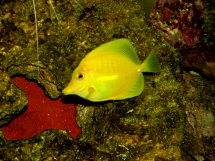 |
|
Please help my tank! 3/27/10
Hello,
<Hi there Marilyn>
I have a tank that has been established for over a year, and my
son has been taking some of my fish to his newly established tank
in Boston.
On Monday I received 3 new small yellow tangs. They seemed to be
doing fine, until I got up this morning and checked the tank. Two
of the three tangs were dead and the third only lived for another
hour or so!
<Look very stressed in your pix... from something...>
Please help me find out what caused their death. I have attached
two photos that I took before all three were dead. I had put them
in a separate tank and put some CopperSafe in it but to no
avail.
<See WWM re Copper use and Acanthurids/Tangs... not a good
idea>
Any help you could provide would be greatly appreciated. I
checked and rechecked all of the levels in the tank and they
seemed fine. And my cleaner shrimp and feather duster are still
alive.
Baffled and sad on Cape Cod.
<Please read here: http://wetwebmedia.com/ytangdisfaq3.htm
and the linked files above. Something... chemically, physically
and/or biologically did not "agree" with these Z.
flavescens. Bob Fenner>
|
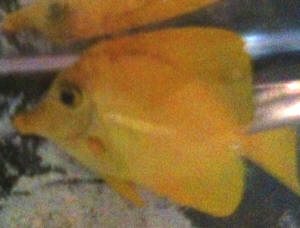 |
Yellow Tang Ich in Quarantine treatment with CopperSafe --
02/14/10
I have a yellow tang. Put him in 20G quarantine and he developed Ich
within a couple days. I have been treating with CopperSafe
<I wouldn't do this. Read here:
http://wetwebmedia.com/tangdisfaq4.htm
and the linked files above>
following manufacturer's directions for 2 weeks now, and all spots
have been gone for 10 days. How long do I keep the Tang in the
quarantine before introducing to main tank?
<Two to four weeks more... See WWM re. Bob Fenner>
Kevin Melendrez, Ph.D.
Yellow Tang and Salinity/Tang Health/Systems
1/28/10
Hello crew,
<Hello Chris>
Hoping you can help again, I have noticed my Yellow Tang breathing
quite fast over the last 2 days, also quite skittish. I have had him 3
months, he is eating well and no signs of spots or any other visible
disease, colour is
ok. I have tested all the water parameters today, all OK except
salinity which is high, 39ppt. Double checked and recalibrated the
refractometer and same. I know this is not good and I don't know
what went wrong but am in
the process of correcting this now, silly question I know but would
this stress the tang out, clownfish seem ok and they are the only other
fish plus
2 shrimp. Many thanks.
<The 39ppt (1.029) shouldn't stress the tang out provided this
were a very gradual increase and the tang is kept in environmental
conditions to it's liking.
Hawaiian specimens are generally found in waters with an average
salinity of 34ppt (1.025). Less oxygen is available the more salinity
goes up, so lowering the salinity gradually may help the tang out in
that regard providing there is no unseen or seen disease present.
Do read here and related articles/FAQ's for information on keeping
this fish.
http://www.wetwebmedia.com/YellowTang.htm
James (Salty Dog)>
Regards,
Chris.
Re Tang and Salinity/Tang Health/Systems 1/28/10
Hello James
<Chris>
Thanks for the prompt reply,
<You're welcome.>
tang has been in the tank 3 months no problems, same clownfish with
him, he always seems quite happy playing about with the large female
clown which is strange, never shy's away from the glass but is now,
nothing new added since his arrival, I am double checking my salt mix
which I always have on the go also rechecking refractometer, and
starting to lower the salinity in main tank, thanks again for your
help, appreciated.
<You're welcome, and you might want to read Tang Behavior
FAQ's here. You may find a similar queries leading to more info
re.
http://www.wetwebmedia.com/tangbehfaqs.htm
James (Salty Dog)>
Regards,
Chris.
Red veiny lines on Yellow Tang, ref. 1/6/2010
Hey good afternoon,
<Still AM here in sunny S. Cal.>
I have a question about my yellow tang. He (or she) is very active eats
well and has all signs of a healthy fish.
<... you're sure you searched this on WWM?>
However he spends a lot of time with his tail brushing sand around and
it is causing his tail fin to look a little fraid. The tail also has
red almost vain like lines going through it. I have had him now for 2
months and he started off a brilliant yellow and is now got these small
red veiny lines in his tail. The tank is fairly new (only 3 months) and
is due for its second water change.
<?>
Everything tests good. Salinity gravity at 1.023, pH @ 8.16, No trace
of Ammonia, Slight trace of Nitrite @ 0.05 and Nitrates have built to
50ppm.
<Way too high, toxic... a factor here>
I did light dose with copper
<? What for? Not in the main display. A mistake>
about 6 weeks ago and that tested @ .25 ppm a week ago. I have heard
the positives/negatives about dosing with copper and still went
ahead.
<Yet didn't follow instructions before writing us... Please do
as a few tens of thousands of users per day do...>
I try to feed seaweed on a clip (which he loves) and I have been mixing
up the food base from flakes to a marine veggie cuisine to a freeze
dried brine. I'm wondering is it a water quality issue or am I not
feeding it the correct supplements. Oh and lastly his tank mates are 2
yellow tail damsels a hippo blue tang (added the same time) and just
recently ( 2 days ago) a maroon clown
<The alpha fish>
and a small green bird wrasse). The tank size is 80 gallons and he has
had the red veins on his tail now for about 2 weeks, Its is more visual
at first sight in the morning. What could this be?
Thanks,
Troy
<Read here: http://wetwebmedia.com/ytangdisfaq3.htm
and the linked files above, elsewhere on WWM re NO3... and copper use.
Bob Fenner, persnickety this AM>
Red veins on Tang Solved (I hope)
Hey thanks so much!!! I believe my issue is poor water quality with my
tang and the red veiny look.
<Ahh! I do agree/concur>
I was able to look it up and once again thanks for steering me in the
right direction. Any web-sites that you would recommend for mail order
fish?
<See WWM re... my fave is Dr.s Foster & Smith in general>
I live 2 hours one way from closes fish store and its a pain in the
backside.
<Wow! I bet>
Nor. Cal., Mendocino Coast. Once again thanks for the direction.
Troy
<Thank you for sharing. BobF>
Yellow Tang, QT, hlth. 12/11/09
Hello I have a yellow tang in quarantine, tomorrow will be 16 days and
I was going to add him to the main tank.
<Ok, but is generally recommended to QT for 4 weeks, but 2 is better
than nothing.>
Well when I feed him today I turned the tank pumps off and when the
water was still I noticed what looked like a few specs of dust that
were swimming around it was almost like they were moving with tiny
tails but they were so small it was hard to tell.
<Possible some sort of microcrustacean.>
At first I thought that's interesting then I thought all
<<maybe "oh?" RMF>> no Ich has a free swimming
stage.
<Not visible to the naked eye.>
I have not noticed any white spots on the fish and it seems to be doing
well.
<Good>
So I really tried to look him over closely and he does have a few tiny
bumps on both sides of his body towards his tail end they are yellow
the same as the rest of his body. I was wondering if this is normal or
if the whole side of the fish should appear smooth even under close
inspection.
<Most likely nothing to worry about and normal.>
I don't like the idea of fresh water dips seems very stressful to
me and the fish plus I have read when a parasite is under the skin they
do no good any way.
<If done properly freshwater dips are well tolerated by most fish,
and can be useful several ailments, however you are correct about them
being minimally effective for Ich.>
Would it be OK to still introduce this guy to my main tank tomorrow?
Any ideas what the swimmers may be?
Thanks
Chris
<I think it is fine to add, little danger of these
"swimmers" being a problem.>
<Chris>
|
Yellow Tang, hlth. 12/3/09
Hello, I have a yellow tang in quarantine has been there almost a
month, since I have had him he has filled out and is looking very
good, lots of colour and fins nice and erect he eats anything
that goes in, but have noticed that he swims really fast and
erratic, shuddering movements back and forth then off he goes
again back into a flowerpot, the thing that worries me most is he
seems to flick his body against the heater and the side of his
flowerpot and then does a lap of honour around the tank at high
speed, there are no signs of any spots or marks etc could it be
some other sort of parasite or just tang behaviour, many
thank,
Regards Chris.
<All reads as "normal", i.e. healthy behavior.
Zebrasoma tangs suffer for being kept in small volumes... w/o a
sense of being able to "get away". The likelihood that
this fish harbours communicable, parasitic disease is vanishingly
small at this point. I would pass it through a pH adjusted
freshwater bath, and place it in your main/display. Bob
Fenner>
Re: Yellow Tang
Thank you Bob for the prompt reply, appreciated, have been
reading up on FW dips and other treatments for parasites etc so
will now give him a FW dip
thanks again,
Regards Chris.
<Glad to aid your success Chris. BobF>
Re: Yellow Tang, hlth.
Hello again Bob, sorry to be a pest, do you think that one FW dip
will suffice ?
<Yes>
and just to clarify you say to put him straight into the display
after the dip ?
<Correct>
is there anything I should look out for after the dip i.e.
behaviour from the tang what to look out etc, many thanks
again,
Regards Chris.
<Mmm, yes... do keep an eye on the fish for signs of oxygen
stress... add an airstone/pump if you have one, or agitate the
water with your hand during the process. See here for more:
http://wetwebmedia.com/dips_baths.htm
"and the linked files above"... BobF>
Re: Yellow Tang
Thanks again Bob greatly appreciated as you can tell new to
marines,
Regards Chris.
<Welcome Chris! B>
Re: Yellow Tang 12/5/09
Hello Bob.
<Chris>
Sorry to bother you again, but just some updates on the yellow
tang, taken onboard all you have said about the tang in a
confined space and that will be sorted very soon, and have read
LOTS of the related articles/threads,
anyway have not yet FW dipped him as have been observing him
closely in case I missed something plus need to get out and get
an air pump (when I get a minute from work) have noticed first
thing in the morning he is very calm
and gill rate breathing quite slow, but after the lights go on
and people about it's then he starts his flashing and gill
rate breathing increase quite a lot, I guess again stress ?
<Yes>
as if it was gill fluke or something similar would breath rapidly
all the time ? I will still be giving him a FW dip,
but would like to know your thoughts on the breathing, many
thanks,
Regards Chris.
<Dip and move this fish. BobF>
Re: Yellow Tang 12/6/09
Thanks Bob making preparations now, have RO heating up the ph is
low 6.5 so need to bring that up 8.2 both QT and display same so
that's a plus, I have bicarbonate of soda , can't find
any info on how much bicarbonate to use ?
many thanks,
Regards Chris.
<Mmm... a tsp. or so in a gallon or so will likely do here.
Sodium bicarbonate will not dangerously over-elevate pH...
Maybe give a read here if interested in its applicable
chemistry:
http://en.wikipedia.org/wiki/Sodium_bicarbonate
BobF>
Re: Yellow Tang 12/6/09
Hello Bob, well the tang is in the main display and is 100%
better than he was, he is grazing on the LR eating flake and
seems a LOT happier, a couple of photo's attached,
Regards Chris.
<Ah, good. B>
Re: Yellow Tang -- 12/09/09
Hello again Bob, just to let you know the tang is really looking
good now
(thanks to your help/advice), fantastic colour and gill rate
normal really likes his new surroundings and his tank mates pair
of clarkii clowns, the tang is feeding on Nori, flake and Mysis,
his only problem now is the greedy female clown competing for
food, who I just noticed swallowing a piece of coral shell in a
feeding frenzy, do fish regurgitate what they can't digest or
does it just pass though somehow ?
<Some of both>
once again many thanks for your help with the tang greatly
appreciated,
Regards Chris.
<Glad to aid your successes. BobF>
|
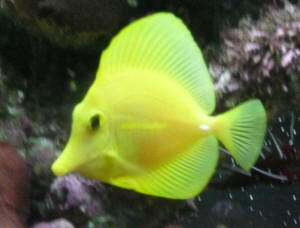 |
Having problem with yellow Tang: Newer tank setup: Zebrasoma
Systems\health 11/27/2009
Hey
<Hi Troy>
I was hoping you could answer a question regarding a yellow tang that I
have?
<Sure.>
In my 55 gallon tank with live sand and an Eheim canister filter
(powerful enough to run 80g) I have 4 small damsels a small Ocellaris
clown a Maroon clown and the yellow tang.
<You are going to have problems with that stocking list. Maroon
Clowns get aggressive with time, as do the damsels. Further, a 55 is
marginal for a yellow tang.>
The water temp has been at 79 degrees and the salinity at 28 ppt and
1.021 gravity.
<Salinity is a bit low - 1.023 - 1.025 is preferred>
The Tang has no noticeable spots and great color, however last night I
did a water change (my first one , new tank) he is now laying on the
bottom of the tank, breathing hard and not eating.
<Did you test the water after the water change? What about ammonia
and nitrite levels?>
His stomach does look slightly pinched. I have had the tank set up for
over 6 months and 2 months ago started added fish. First the damsels.
then the ocellaris then the tang. The Tang has been the best fish in
the tank very active and great appetite.
<They are a very good fish in the right environment.>
I feed Nori, fish flakes (formula one flakes from ocean nutrition) he
will also eat freeze dried brine shrimp and frozen Mysis shrimp. It was
suggested to me by my local aquarium store to run copper power ( a
copper treatment) in the tank
<Ugh.... There are only a few reasons to run copper, and it should
never be run in a display tank. It should never be administered
'just because' as it can poison the tank.>
I asked for 1oz per 20 gallons. I have a 55 gallon so I thought safe to
put 2.5 oz for 50 gallons. This treatment was done after the damsels
but before adding any of the other fish, at least 6 weeks now.
<Ok>
I have had the Tang for 4 weeks and like I said he's been great up
until the water change I did last night? I noticed the behavior this
morning when I got up? I can easily catch him with the net (no way
possible before) and he just is laying on the bottom? Any
suggestions?
<Do test your water immediately for ammonia nitrite and nitrate -
don't use test strips, they are notoriously inaccurate. Ammonia and
nitrite need to be 0, nitrate needs to be less than 20ppm for
everything to thrive. Below are some links to some very helpful
articles that will give you a point in the correct direction.:
http://www.wetwebmedia.com/watrqualmar.htm
http://www.wetwebmedia.com/toxictk.htm
http://www.wetwebmedia.com/stocking1.htm
http://www.wetwebmedia.com/YellowTang.htm
http://www.wetwebmedia.com/maroonclnart.htm
http://www.wetwebmedia.com/marclncompfaqs.htm
>
Troy
<MikeV>
Y. Tang, hlth. 11/10/09
Hello,
<Hi there>
I've got a mysterious bubble of gas stuck in my yellow tang.
I've noticed its formation about 4 months ago, ever since it has
been getting bigger and bigger. Now it appears like the fish is going
to pop any day and die from it. It's definitely not pregnant, I'm
thinking it has some kind of blockage in its intestinal track (not
likely) or that his gas bladder is dysfunctional.... any
thoughts/suggestions?
<Perhaps the Epsom Salt route. Please search WWM re. Bob
Fenner>
Thanks,
Matthew
Yellow Tang, Crypto, Reading -- 11/04/2009
Hi,
<Hey there! JustinN here!>
I have a yellow tang in a 55g tank i also have 3 yellow tail damsels, 1
bicolor Dottyback, and 2 scooter blennies. The tank has been up since
September-19-09.
<This tank is too small ultimately for the Tang, and likely too
immature to support even a single scooter blenny, much less two. The
tang has potential to outsize the tank very quickly, and the scooter
blennies are obligate fauna feeders -- they will pick your tank clean
of their necessary food source quickly.>
I got a yellow tang on October-3-09 and he was doing fine until I had a
Ich infection which i treated with Kordon Rid-Ich+.
<Treated in your display? This should be done in a quarantine
tank.>
I am still treating with this the yellow tang has no visible signs of
Ich but the Dottyback does.
<Is parasitic, and communicable to all fish in a mixed display here.
This is why Quarantine is so important.>
I have just noticed (about 3 days ago) red spots on the Yellow tang and
they seem to be getting worst by the day.
<Sounds like chemical burn/irritation here>
He looks like he has hole in head. The red spots are at the tail. I
can't identify what they are. My tanks recent test values are as
follows: Nitrate-30, Nitrite-0, Alkalinity-300, pH-7.9.
<What is your Salinity at? Your pH is a bit low, should be in the
8.1-8.3 range -- Nitrate should be at, or as close to, 0 as possible.
The nitrate alone may be enough to cause the burning, but if the
Formalin/Malachite
solution is being dosed too highly, this could easily cause the
'burning' as well."
Their is a small electrical current measuring .002v in the tank.
<Most likely unrelated, but there shouldn't be stray voltage in
your tank.>
The filtration is a emperor 400 filter and a coral life super skimmer
for a 125g tank.
<The main thing you need here is some reading -- your tank is very
immature, and is likely still going through its establishing nitrogen
cycle. Exacerbating this is your stocking levels -- you have too many
fish, far too soon, and the tank is still attempting to establish its
biota balance. In addition to this, by treating your display tank with
the Formalin/Malachite compound, you are effectively killing all
beneficial bacterium/biological filtration available in your tank.
These medications treat indiscriminately. More reading is in order --
start here:
http://www.wetwebmedia.com/formalinart.htm
http://wetwebmedia.com/stocking1.htm
http://wetwebmedia.com/quaranti.htm
http://wetwebmedia.com/watrqualmar.htm
http://wetwebmedia.com/nitratesmar.htm
and related subheadings. -JustinN>
|
Rotting Fin After Freshwater Dip 10/29/09
Hi Bob. I have a quick question for you. My Yellow Tang had
developed some red blotches on its body (see attached picture
entitled "Before 1").
Due to the fact that I had recently lost a fish to some disease,
I decided to quarantine the Tang. I placed it in my QT tank and
later that day freshwater dipped it (matching the temperature and
PH). The dip took about
15 minutes, during which time the Tang laid sideways, but did not
act irate. After the dip, I placed the Tang back into QT.
<So far...>
This morning all the red blotches were gone, but the tang's
fins seemed to be rotting (see attached pictures entitled
"After 1," "After 2," and "After
3"). This literally happened overnight. There is no other
life in the QT, so nothing could have eaten the fins. How is this
possible for this to happen overnight? The before and after
pictures are 24 hours apart. In the before picture, the fins are
smooth, but in the after picture, they are
ruffled and look rotten. Have you ever seen anything like this?
What do you recommend I do?
P.S.
The Tang is not eating, but is swimming about kind of aloof.
<I do think the dip is accountable here... and "general
stress" associated with it... This fish looks in good shape
otherwise, and I do think that if it was moved to propitious
circumstances following the bath, all should be fine here. Bob
Fenner>
|
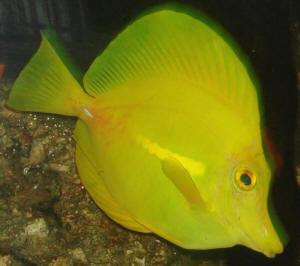
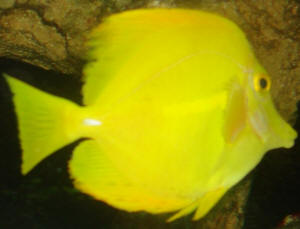 |
|
Re: Rotting Fin After Freshwater Dip
11/6/09
Hi Bob. Thank you for the answer. The tang recovered and is
eating perfectly.
<Ahh!>
Unfortunately, the red blotches on its body are coming back (see
attached picture). It is still in quarantine, but not being
treated with anything. What do you recommend?
Thanks,
Eugene
<Time going by, good care. Read here:
http://wetwebmedia.com/ytangdisf7.htm
and as much of the linked files above as takes to convince you.
The red markings are environmental. BobF>
|
What's that stuff in my tank?? No pic... Yellow tg. env.
hlth. 10/2/2009
Hello - thank you for a wonderful site!
<Howdy. Welcome>
I have a 55 gal salt water tank and I have a Yellow Tang and some
damsels in it. The other day my daughter said that my Tang had some red
dots on his head - I could not see them - but well hey I wont mention
my age :)..
Yesterday when we came home from school my tank had a black growth (it
had long furry/grassy stuff) - anyway I went ahead and dug that stuff
out and did a 25% water change. What is that stuff?
<Could you send an image?>
It almost looked like black grass - maybe??
<Not a graminean assuredly>
Not sure how to explain it.
<A photo...>
The sand had a growth/crust as well. My tang was ok this morning -
still had the red blotches (looks like blood on his fins next to his
body and on his mouth). I read some other emails and answers you have
given about things like the bloody look on the tangs and have made sure
he had seaweed and flakes to eat.
<More likely environmental in origin...>
I guess my main questions is what is that black stuff? And is my
"Tangy" going to die? (The other fish are fine - and Tangy is
acting somewhat normal).
<Please read here: http://wetwebmedia.com/ytangdisf7.htm
and the linked files above...>
I've got two other tanks but one I just refilled and letting it
cycle and the other is a 90 gal tank that is real close to the 6 weeks
cycle and I can move fish in soon do I need to put Tangy in there and
it be a QT tank and do I need to put meds in this water?
<I would move this Zebrasoma now>
Have I confused you?
<No>
I'm just worried about Tangy - he is a funny fish and is VERY
spoiled and we really like to sit and watch him.
(Oh before I forget I have not done anything different or added
anything to the tank lately).
Thank you for everything! All this is a on going learning process.
Cecilia Lester
Paris Texas
<Ah yes. Cheers, Bob Fenner, San Diego, CA presently>
|
Sick Tang 09/15/09
Hi guys,
need help, a fellow reefer passed away last week and some of my
reef club members got together to help the widow out.
<Ah, good>
She wanted all livestock to go to good homes and remove the
entire tank.
The tank was a 325 glass tank which may have been neglected due
to the owner's illness. Anyway, I took a 4" yellow tang
and a royal gramma along with some Tonga rock and some coral.
Unfortunately it took about 7 hours to move the fish from an
Instant Ocean pail to a 20 gal tank I had setup at home. This was
due to us emptying and moving the main display tank. I have had
the fish since Saturday and the Tang does not look good. It is
not eating and has a white film over both eyes and front of head,
see pics attached. Any suggestions to help the tang would be
appreciated. The gramma also had a few similar spots on it but
looked better today, also not eating.
thanks,
Frank
<Mmm, a toss up between causing further stress from
manipulating this animal (for what good it might do...) and just
leaving be and hoping. IF you are wanting to "do"
something, I would net this fish out and gingerly
daub a dilute solution of either an iodide or mercuric based
(e.g. Mercurochrome) liquid prep. (with a cotton swab) on the
afflicted area... yes, including the eyes... This may arrest the
further decomposition to an extent. Otherwise, "just time
going by" in your good care will prove whether these fishes
will improve/survive. Bob Fenner>
re: Sick Tang 09/15/09
Bob,
Thank you for your prompt reply. I am assuming you took a look at
the pics provided, this condition is a result of stress/neglect?
I was concerned that it may be some type of fungus or other
illness.
<To extent Frank... perhaps a physical injury was the
origin>
If not, then I believe I will take your advise and hope that it
will recover. I'll keep water conditions pristine and hope
for the best. I don't think that netting it again will be
advantageous.
thanks again,
Frank
<I agree. Thank you, BobF>
|
 |
Yellow tang didn't make the night... killed by improper
env. 8/24/09
Hello WWM Crew,
<G>
I have a new 24g salt water set up.
<... this is way too small for a Zebrasoma species. Read here:
http://wetwebmedia.com/ytangsysfaqs.htm
RMF>
It's been cycled and water tests show good. I've had 3 blue
Chromis that are doing fine. Unfortunately the
yellow tang I just got didn't make it through the night. Heart
breaking since I thought they're one of the tougher fish for a
newbie. I acclimated the tang to the water properly before I put him in
and he seemed fine. He seemed to be eating within the first few hours,
so I can't imagine why he didn't make it. I initially needed
him since I have green algae on the walls of the tank and it seems like
darker brownish algae that collects at the bottom. Any popular reasons
he\she didn't make it? What should I do to ensure the next one
makes it? thanks GeraldB
Yellow tang problem, 6/17/09
I got a 55 gallon fish only tank from a couple moving to Germany about
a month ago.
<Nice>
I have a very small amount of experience with saltwater fish (clown and
blue damsel in a 20 gallon tank for about 6 years now). The tank had
been badly neglected before I moved into my house. After the ordeal of
moving settled down for the native fish (green bird wrasse, maroon
clown, three striped damsel, 2 feather dusters, and a pencil urchin) I
decided to add a yellow tang about a week ago.
<Will outgrow this tank, and may get badly bullied by the current
livestock.>
The tang has lightened in color progressively worse over the last week
to a point of almost completely white with a yellow stripe. The tang
has been eating great; seaweed clipped to the side, and an assortment
of frozen foods from San Francisco bay brands, and even omega one flake
food. I wasn't too concerned about the color change after reading
multiple posts online about stress related "paleness".
<Stress can lead to may other problems, is something to be concerned
with.>
Tonight while feeding I noticed a deep red spot that slightly bulges
out on the base of the left pectoral fin, and I am concerned. Ammonia,
and nitrite levels are 0. Ph is 8.2. Temperature is 79. Nitrate it s
pretty high.
When I got the tank set up at my house last month the nitrate levels
were off the page (160 is as high as the card goes) I kept about 90% of
the original water. I have done about a 20% water change once a week to
get the nitrate level down to 50, still high but steadily dropping.
<This is probably part of your problem.>
I figured the nitrate level would be ok for a fish due to the good
health of the urchin (as much as an urchin looks healthy).
<Not necessarily, is probably causing a good part of your
issues.>
Could the high nitrate level be to blame for the health of the
tang?
<Yes>
Could it be some other health issue treatable with a fresh water
dip?
<Not likely.>
Should I move the tang to the small tank and use the shotgun approach
to fish medical care?
<I would not.>
Any help would be appreciated.
Bill
<Improve the water quality first and foremost. After that I would
consider returning the tang as you are at the very minimum required to
keep it long term, and with your current aggressive tank mates I think
you will run into problems.>
<Chris>
Urgent issue with Yellow Tang - 06/05/09
Please help - I got my first fish two weeks ago after my local shop
said my water was ready for fish.
<Dubious qualification....do bear in mind they seek to sell
fish.>
He seemed fine at first but last few days seemed to be darting about a
bit more and not just swimming naturally. However he was eating fine
and water tests showed to be ok.
<What are you testing for? Ammonia? NO2, NO3?
I've come home tonight to find him quite listless, a bit pale and
breathing quite fast. He also didn't react to feeding like he did
this morning. I've done a partial water change but as its nearly
midnight I only have about 15 litres of RO water here and the tank is
holding around 160 litres. This is obviously not enough but Im not
going to be able to get to the shop till they open in about 9 hours. I
desperately want to save him so is there
anything else I can do? Or what is the best way to treat tap water
ready to be mixed with the minerals as a temporary measure?
<Jo, this sounds to me like ammonia or nitrite poisoning. Was the
tank cycled? Do you realize this will be woefully inadequate space for
a yellow tang in the future? If the fish is still alive, do get your
hands on water
fit for making WCs (deionized from the grocery works in a pinch,
although it can be tough on the wallet) and run an airstone of some
sort into the water...keep an eye on pH. Do read on WetWebMedia re:
cycling, new aquariums, stocking, etc.>
Please help!
<Hope I have. Best of luck,>
Thanks, Jo
<Benjamin>
Surgeonfishes: Tangs for Marine Aquariums
Diversity, Selection & Care
New eBook on Amazon: Available here
New Print Book on Create Space: Available
here
by Robert (Bob) Fenner |
 |
|
|

